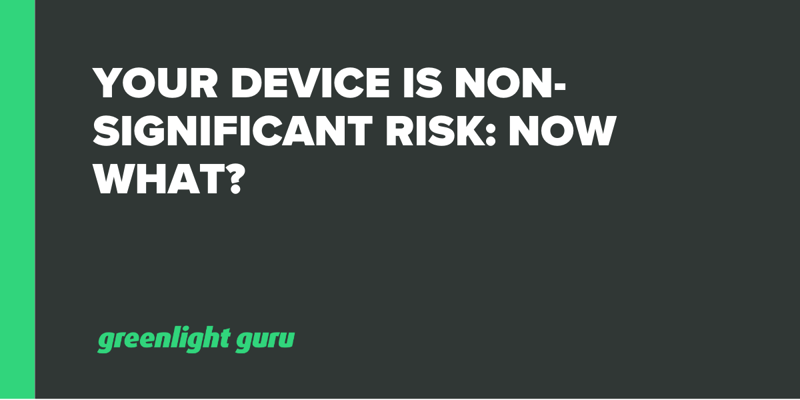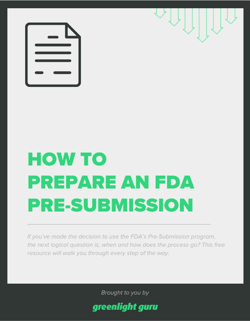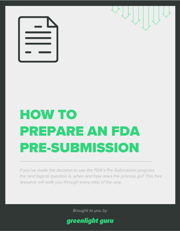
If you need to conduct a clinical investigation of your device before it has received market approval, then you’ve probably found yourself looking through the FDA’s guidance on an investigational device exemption (IDE).
The IDE application process is the FDA’s way of ensuring that your investigation is scientifically sound and that the benefit-risk profile of the device is acceptable.
However, one big caveat here is that you only need to apply for an IDE if your device is deemed to pose significant risk (SR). If your device poses non-significant risk (NSR), then you do not need to apply for an IDE.
There’s plenty of information out there on the IDE application process and the regulations around SR device studies, but much less is available on what you need to do if you have a non-significant risk device. In this article, I’ll be clearing up any lingering confusion over what your next steps are if you have a non-significant risk device.
What is the criteria for a non-significant risk device?
There are no set criteria for a non-significant risk device. However, in 21 CFR 812.3(m) you’ll find a list of qualities that indicate a device poses significant risk, including when the device:
-
Is intended as an implant
-
Is used in supporting or sustaining human life
-
Has substantial importance in curing, mitigating, treating, or diagnosing disease or preventing impairment of human health
-
Otherwise poses a potentially serious risk to the health, safety, or welfare of subjects
If your device does not meet any of those criteria, then it likely does not pose significant risk. Some examples of NSR devices include:
-
Contact lenses
-
Denture repair kits and realigners
-
Low-powered lasers for pain treatment
-
Externally worn insulin monitors
-
Foley catheters
Does FDA need to confirm that your device is non-significant risk?
When FDA reviews an IDE application for the first time, many medical device professionals are surprised to learn that they do not make the call on whether a device is significant risk or nonsignificant risk. Though FDA provides the criteria by which to make the determination, the decision is left up to you, the medical device manufacturer.
If you’ve determined that your device is NSR, then you are not required to submit an IDE application and you are not required to inform FDA about your clinical study. Still, it can still be a good idea to notify FDA of your intentions in your premarket submission.
Mike’s point is that this is a matter of professional courtesy—a way of keeping them in the loop. That communication also heads off a worst-case scenario: FDA informing you that they believe the device to pose significant risk after your clinical study has already concluded.
To recap: you’re not required to tell FDA about your NSR clinical study, but it may be a good idea to do so anyway.
So, who needs to review your proposed non-significant risk study?
Just because FDA isn’t taking a hands-on approach, that doesn’t mean you can immediately conduct a study whenever your device is ready. You’ll first need the approval of an institutional review board (IRB) at the hospital, medical school, clinic, or other facility you would like to conduct the study at.
The IRB is essentially acting as the FDA’s proxy. You’ll need to present them with the justification for why your device does not present significant risk, and FDA considers your non-significant risk device to have an approved IDE once the IRB agrees with your classification and approves your study.
Now, it is possible that the IRB could disagree with your claim, in which case you’re responsible for reporting their decision to FDA within five working days.
In this case, FDA is the final arbiter of whether the device does or does not pose significant risk. If they determine the device is actually SR, you may not begin your study until you’ve submitted an IDE application and FDA has approved it.
How does non-significant risk status affect your responsibilities as the sponsor of the device?
If the IRB agrees that your device poses non-significant risk, you’ll have different record keeping and reporting requirements for your clinical study.
For one thing, you do not need to report to FDA that your non-significant risk study has been approved by the IRB. The approval and the study itself can happen without the FDA’s knowledge, and the study can begin at the institution once the IRB has approved it.
You’re also not required to make progress reports or send final reports on the study to FDA. And while you will need to follow many of the same requirements related to informed consent, labeling, and records as a significant risk study, you will be subject to an abbreviated set of requirements.
What are the abbreviated IDE requirements for non-significant risk studies?
The full text of the abbreviated IDE requirements can be found in CFR 21 Part 812.2(b), but the main points are as follows:
-
You must obtain and maintain the approval of the IRB throughout the study.
-
Your device must still be labeled in accordance with the requirements in the IDE regulations in 21 CFR 812.5 and needs to have the following statement on it: "CAUTION - Investigational Device. Limited by Federal (or United States) law to investigational use."
-
You must make sure that investigators obtain informed consent from each subject and document it.
-
The investigation must be monitored in order to protect the subjects and ensure compliance with approved protocols.
-
You need to maintain records and make any reports that are required by the IDE regulations. You also need to ensure that the study’s investigators maintain records and make any required reports.
-
Any commercialization, marketing, promotion, or misrepresentation of your device are prohibited, as is unduly prolonging the study for any reason.
Securely share key documents and records with external stakeholders with Greenlight Guru’s document management software
Even with a non-significant risk device, gaining IRB approval and conducting a clinical study requires an enormous amount of documentation and strong alignment between you, the IRB, and the clinical investigators conducting the study.
With Greenlight Guru’s Document Management Software, you can rest easy knowing that not only are all your documents up to date and easy to find, but you’ll also be able to securely share them with external stakeholders—even assigning them follow-up tasks and including them in document review and approval workflows.
With everyone on the same page, you’ll avoid costly delays and accelerate your time to market. If that sounds like something your medical device company could use, then get your free demo of Greenlight Guru today!
Looking for an all-in-one QMS solution to advance the success of your in-market devices and integrates your post-market activities with product development efforts? Click here to take a quick tour of Greenlight Guru's Medical Device QMS software →
Laura Court is a Medical Device Guru and Mechanical Engineer who loves learning about new technology and sharing her experiences with others. She has experience in New Product Development and Manufacturing with both small and large companies. Having managed products through their full product lifecycle into post...
Related Posts
How to Set Up Clinical Studies to Comply with US FDA Regulations
The FDA Medical Device Approval Process: Pathways, Timelines, and Tips
What is 21 CFR 812 - Investigational Device Exemption?
Get your free resource
How to Prepare an FDA Pre-Submission











